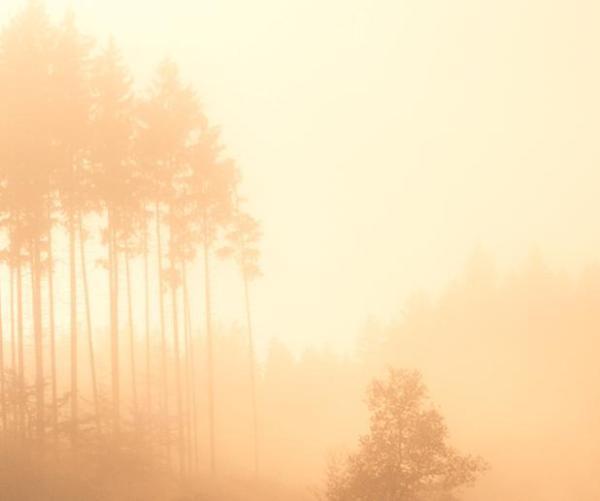
To learn about different cloud types and characteristics, you must pay attention to shape, size, color and cloud formation to identify which type of cloud it is. The formation of different types of clouds depends on the speed of the ascending air current. Cloud formation can be classified as low, medium, high and vertical. Keep on reading this oneHOWTO article to know all the cloud types and characteristics.
Cloud classification
To learn about cloud types and characteristics, you should first know that clouds are classified as cumulus and stratus. Cumulus clouds originate in strong currents of ascending air. The surface of the base is flat and the top takes the form similar to that of a cotton ball. The stratus or stratocumulus clouds are formed when the updraft is very weak. They spread evenly across the sky, without forming a specific shape.

Cloud types by shape
If you know the shape of the cloud masses, their size and the atmospheric layer where they're located, you can get an idea of the type of precipitation that will occur, as well as the intensity.
Low clouds
First of all, let's take a look at cloud types that are small:
Nimbostratus
They look like an even layer of dark grey with varying degrees of opacity. Quite often it's possible to observe a slightly striated appearance corresponding to varying degrees of opacity and variations of grey. They're typically rain clouds in the spring and summer and snow clouds in the winter.
Stratocumulus
They have broad, wavy shapes resembling elongated cylinders and can produce large cloud banks. These clouds have areas with different shades of grey. Stratocumulus clouds rarely bring rain, except when they become nimbostratus.
Stratus
They have the appearance of a grey fog bank without a visible, defined or consistent shape. They exhibit patches with variations of opacity and different shades of grey. During the fall and winter, stratus clouds can remain in the sky all day, giving the sky a gloomy look. During the spring and early summer, they appear at dawn and disperse throughout the day, indicating good weather.

Medium clouds
Next, let's learn about the medium sized cloud types:
Altocumulus (AC)
An altocumulus is a cloud mantle of great horizontal extent, composed of individual clouds with little vertical shape, which may cover the entire sky. Although there are gaps where the sky, the sun or the moon can be observed. Clouds that form this layer are usually grey, but sometimes can alternate with a whitish colour and can be separated from each other. They often form a pattern that looks like a brick wall. Most of the small laminae (plates) that form altocumulus clouds have an apparent width between 1 and 5 degrees. They're popularly known as "sheep clouds". They can be iridescent and with a solar or lunar corona that helps to differentiate them from stratocumulus clouds. Formation size: The base is typically about 3,000 meters, (9,843 ft.) but it can range between 2,000 and 6,000 meters (6,562 and 19,686 ft.). Formation: It consists of water droplets and may contain ice crystals, even at very low temperatures. Weather conditions: They don't produce precipitation, but usually indicate a clear change in weather, indicating the arrival of an impending storm if they increase or appear along with altostratus clouds. Return to the cloud quick menu
Altostratus (AS)
An altostratus is a mantle of grey or blue clouds, with a uniform layer of striated, fibrous appearance. Fully or partially covering the sky and with parts thin enough to reveal the sun at least moderately, as though through a frosted glass. There is no halo phenomenon and is what differentiates it from cirrostratus clouds. The altostratus characteristic is the uniformity of its lower part, giving the appearance of a huge sheet or tent, extending from horizon to horizon. It rarely has holes but always differs in thickness. If it doesn't completely cover the sky, it often has a straight side with a neatly trimmed edge and below, there are cumulus clouds.Formation size: Its base is between 3 and 4 Km.(1.9 and 2.5 mi.) high and can be as large as 7,000 m (22, 966 ft.). Its thickness can range to several miles.Formation: Because they have a vertical shape, they consist of several parts. The lower part consists of water droplets, the middle also has water droplets, but it can contain ice crystals and snowflakes, while the upper part is composed of ice crystals. Weather conditions: They produce precipitation in the form of rain or snow, that's usually continuous, but not very intense. Returning to cloud descriptions
Nimbostratus (NS)
They're rain clouds par excellence, with an even layer of large horizontal shape and moderate vertical form, dark grey with a foggy appearance and they can occupy the entire sky and completely conceal the sun. They often completely cover the entire sky, giving a sad and gloomy look. They lack contours and shape when it's raining or rain is imminent, and in either case, the lower surface of the cloud is so ill-defined that it can be said to be non-existent. This type of cloud is close to the altostratus, differing from them in that they're thicker with a base that's usually lower, giving them a more menacing look. It's the thickest of the stratified clouds, extending from the base of the low clouds to the top of the medium ones. Also, when they completely cover the sky, no other medium clouds are present, while there are almost always low clouds present. Formation size: Their base formation occurs at very different heights, so that they can be considered both a low and medium cloud. It has a greater thickness than in the case of altostratus clouds and can reach 4 Km (2.5 mi). The formation process of nimbostratus clouds is a thickening and higher cloud veil. Sometimes however, this phenomenon can't be observed due to low cloud cover, for example, of stratus clouds. Formation: They consist of droplets and raindrops and depending on the time of year and their vertical development, they may also contain ice crystals

High clouds
Those cloud types that are higher than others also have their own classification.
Cirrus (Ci)
Separated clouds that are white with delicate filaments or are in banks. Or they can be in narrow strips that are completely white or a mostly white color. These clouds have a delicate and silky or shiny and fibrous appearance. Cirrus clouds in the upper atmosphere reveal the presence of moisture and may indicate the arrival of a storm or warm front. Maximum altitude: 10 -11 km (6.3 to 6.9 mi).
Cirrocumulus (Cc)
A bank or thin mantle or layer of white clouds without shading, composed of very small elements in the form of grains, waves, etc. They can be connected or not, and have a more or less uniform shape. Most elements have an apparent diameter of less than one degree. They are signs of jet streams and turbulence. These clouds indicate atmospheric instability and can mean an approaching storm. Maximum altitude: 9-10 km (5.6 to 6.3 mi).
Cirrostratus (Cs)
A transparent, thin, white veil of cloud, that's fibrous (like hair) or can have a smooth appearance, completely or partially covering the sky, with the sun or moon shining through. They don't move quickly and usually produce a halo phenomenon (solar or lunar). However, their presence can often indicate the arrival of a storm or warm front. Maximum altitude: 9-11 km (5.6 to 6.9 mi).
Altostratus (As)
A mantle of grey or blue cloud, with a uniform layer of striated, fibrous appearance. Fully or partially covering the sky and with parts thin enough to reveal the sun at least moderately, as though through a frosted glass. It's composed of cold droplets and ice crystals. They don't form halos and sometimes these clouds produce sleet or mist, although usually they're at such an altitude that the precipitation evaporates before reaching the ground. Maximum altitude: 8-9 km (4.5 to 5.6 mi).
Altocumulus (Ac)
A bank, mantle or layer of white or grey cloud, that's generally with shading, fluffy, composed of laminae (plates), rounded masses or rolls in appearance and sometimes, partially fibrous or diffuse, stuck together or separated. They form what's known as the "cobbled sky". Although they're not necessarily indicative of imminent rainfall, these clouds indicate atmospheric instability and possible sleet or mist. Maximum altitude: 7-9 km (4.4 to 5.6 mi).
Clouds with a vertical shape
Have you ever noticed those cloud types that are not horizontal, but vertical? Here's what their characteristics can tell us.
Cumulus: They're large with a massive appearance and stark shadows and when they're between the sun and the observer, they're grey. They have a horizontal base and on top they have large, vertical protrusions like domes or towers with an appearance similar to a large cauliflower. The clusters correspond to good weather with little humidity and little vertical movement of air. In the event of high humidity and strong updrafts, the clusters can become quite large to produce storms and heavy downpours.
Cumulonimbus: They have a large and massive appearance with a pronounced vertical shape that gives the impression of mountain cliffs and whose tops may take the form of a large mushroom. They also have a smooth or slightly fibrous form where different shades of grey or sky blue can be observed. These clouds can contain large ice crystals in the top part. Cumulonimbus clouds typically produce intense storms with hail.

If you want to read similar articles to Cloud Types and Characteristics, we recommend you visit our Learning category.